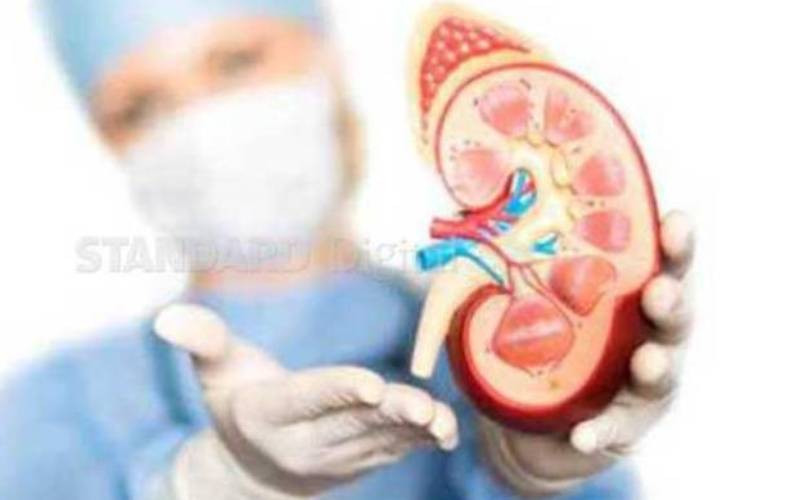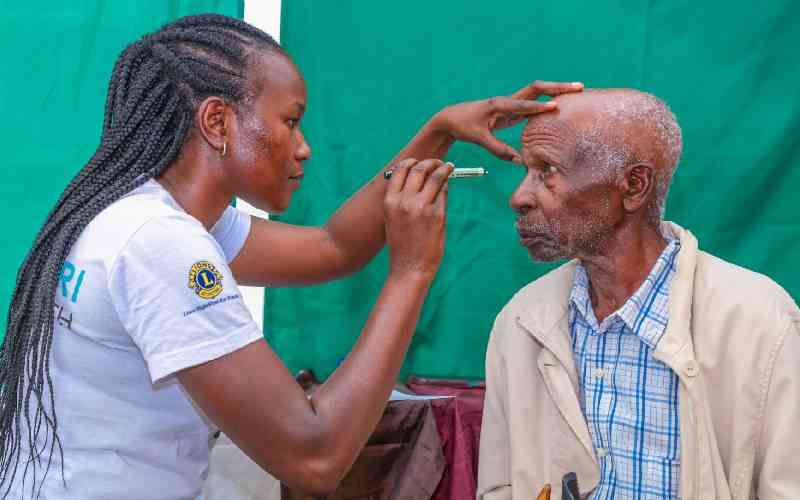
A man undergoes HIV testing in a tent pinched at Mukuyuni market, Makueni county yesterday. There has been a decline in the annual new imfections since 2010 across the country, Aids council reports . Currently new infections stand at 1.9 per 1000 persons in 2017 . [Photo: Stephen nzioka , Standard ]
The search for an HIV cure continues after the discovery that the virus, which hibernates in liver immune cells during long-term treatment, is actually inactive.
Researchers from Johns Hopkins University (JHU) have been focusing on special cells in the liver called macrophages, which are known to be hiding places for the virus in patients who are on anti-retroviral drugs (ARVs).
When HIV-positive patients are on ARVs, the virus hides in cells in different parts of the body, including the heart, brain, lungs and liver. When one stops treatment, the virus starts replicating again and spreads to other cells.
This is why it has proved difficult to cure HIV because researchers have yet to identify all the places the virus hides and come up with what could end up being different treatments.
“HIV can remain in liver immune cells after more than 10 years of ARVs. However, researchers say there is no evidence the liver can be considered an HIV reservoir in this state because the virus can’t replicate at high levels,” says the study, which was published on November 29.
At the moment, all HIV medication targets CD4 T cells, where the virus also hides. ARVs are meant to boost the strength and numbers of CD4 T cells so that they can fight the virus to undetectable levels. Macrophages work with T cells normally to envelop and clear tissues of microbes and debris.
“Our study was the first, to our knowledge, that looked at whether liver macrophages also served as reservoirs, similar to CD4+ T cells, in ART-suppressed, HIV-infected people. We zeroed in on the liver since liver macrophages comprise 80 to 90 per cent of all macrophages in the body,” said Ashwin Balagopal, an associate professor in medicine at JHU who is the lead author of the study.
The study results have been well received by researchers and the 1.4 million Kenyans living with HIV. They strengthen a 2016 study done by Kenyan-born researcher Thumbi Ndung’u, then based in South Africa.
Prof Ndung’u claimed that if one was put on ARVs early, one could live an HIV-free life without depending on drugs by achieving up to 84 per cent viral suppression levels.
“If a patient is put on ARV therapy in the early stages of the disease, in two or three years' time, the patient can be 'deliberately' withdrawn from the medication and still have a strong immunity," he said.
The study, which was made public in September 2016, showed that ARVs suppressed the virus to not just undetectable levels but also made it inactive
"Putting one on ARVs early is meant to slow virus multiplication and prevent damage to the immune system. Starting early means we will have a 'functional cure' but we have to understand that there is no cure at the moment," Ndung'u said.
In this latest study, liver tissue samples were taken from nine HIV-1 infected persons, seven of whom underwent liver transplantation at the Johns Hopkins Hospital and otherwise would have had their livers discarded because they were no longer functional or cancerous.
Eight of the nine persons were on ARVs for periods ranging from eight months to approximately 12 years. Lab tests showed that HIV-1 was present in the macrophages even after exposure to ART.
Liver macrophages
"However, when we tried to simulate virus 'rebound' by activating liver macrophages to see if the virus was infectious or non-infectious, we found HIV-1 at low levels, without the ability to replicate at high levels needed to re-establish infection," said Abraham Kandathil, a research associate.
In the end, the researchers concluded that while liver macrophages might harbour HIV-1 for a long time, it is unlikely the viruses could continue an infection on their own.
"While we have potentially ruled out the liver as an infectious reservoir, it is important to identify all of the relevant virus reservoirs in the body, such as the brain, since it's likely that the virus hides in the DNA of different cell types and will require different strategies to cure. Then we can move forward to finding a 'functional' HIV-1 cure that's comprehensive," said Prof Balagopal.
 The Standard Group Plc is a multi-media organization with investments in media platforms spanning newspaper print
operations, television, radio broadcasting, digital and online services. The Standard Group is recognized as a
leading multi-media house in Kenya with a key influence in matters of national and international interest.
The Standard Group Plc is a multi-media organization with investments in media platforms spanning newspaper print
operations, television, radio broadcasting, digital and online services. The Standard Group is recognized as a
leading multi-media house in Kenya with a key influence in matters of national and international interest.











